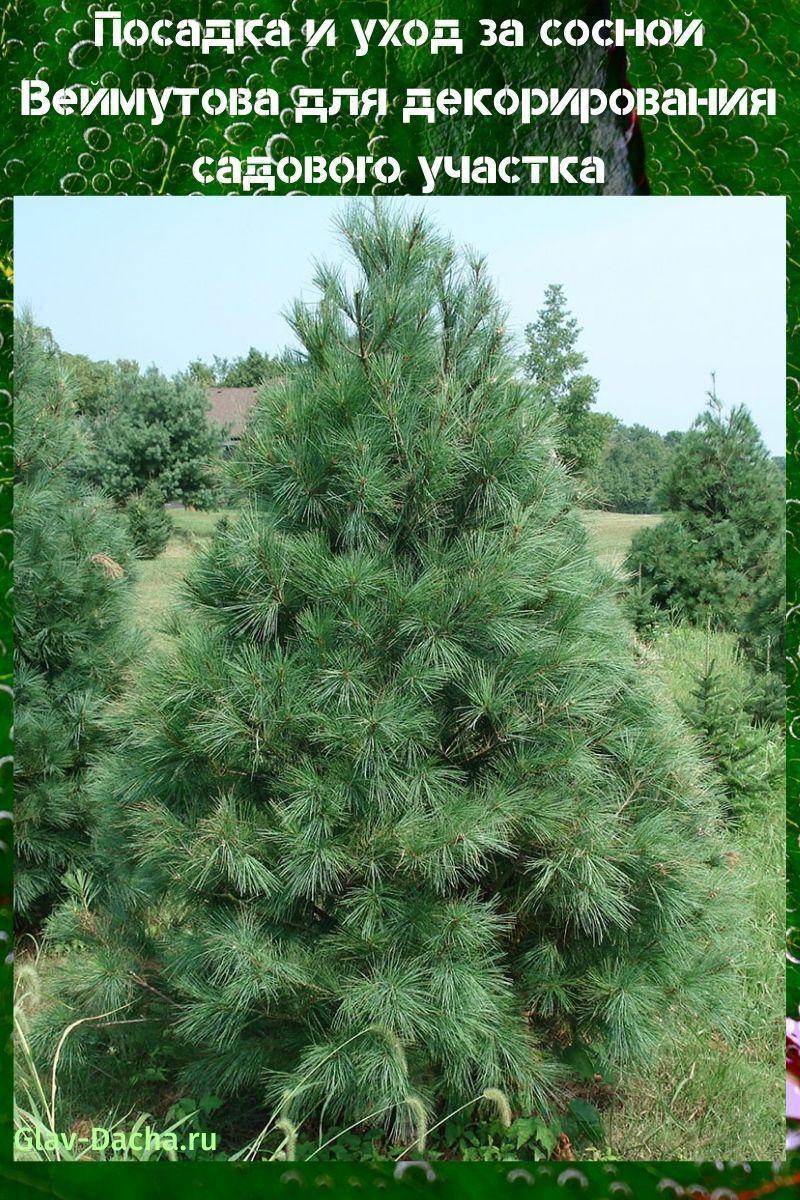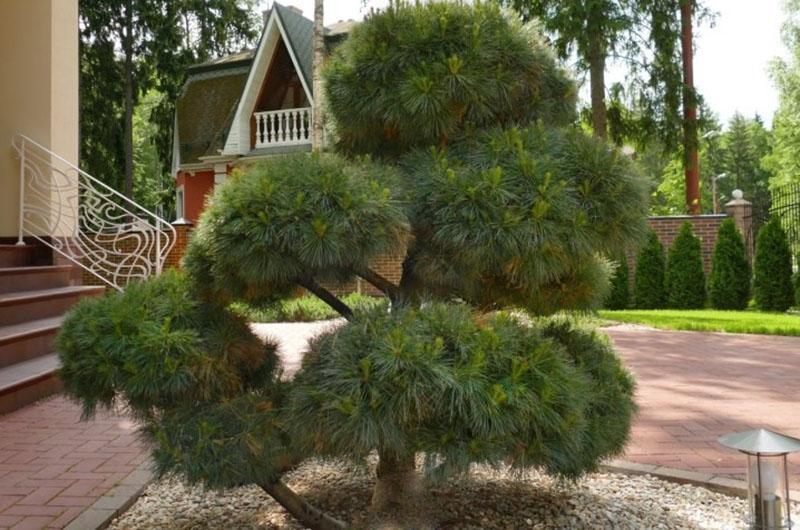Planting and caring for Weymouth pine for decorating a garden plot
 Weymouth pine is an ornamental plant that is used by many summer residents and gardeners in order to recreate a real pine forest on their personal plot. Planting and caring for Weymouth pine have their own rules and characteristics. If you follow them, you can grow a powerful and aesthetically pleasing tree that will decorate any patio, rocky garden or flower garden.
Weymouth pine is an ornamental plant that is used by many summer residents and gardeners in order to recreate a real pine forest on their personal plot. Planting and caring for Weymouth pine have their own rules and characteristics. If you follow them, you can grow a powerful and aesthetically pleasing tree that will decorate any patio, rocky garden or flower garden.
Features of Weymouth pine

Today Weymouth pine also grows in Mexico, Canada and Guatemala.

The main botanical features of Weymouth pine:
- Weymouth Pine is distinguished by its huge size - an adult tree can reach 40-80 m and up to 1.5-2 m in diameter.
- The crown is of the correct conical shape, over time it becomes more rounded and spreading.
- The trunk of the pine is erect, covered with a smooth and delicate gray bark. With age, the bark darkens, coarsens and becomes covered with longitudinal cracks.
- Bluish-green needles with a bluish tint. Coniferous needles are collected in bunches-tassels of 5 pieces, their length reaches 8-10 cm. The needles grow upward, every 3-4 years they are completely renewed.
- Original varieties of Vemutov pine with golden and silvery needles, as well as changing its color throughout the year, were bred.
- Weymouth pine as a dioecious tree has female and male cones. The first are brown, have an oblong, oval shape, up to 18-20 cm long, the second are round, yellow, up to 1.5-2 cm in size.
- Weymouth pine is a long-liver. She can live up to 400-500 years.
Weymouth Pine is very fast growing. During the first 35-40 years after planting, the tree grows up to 15-20 m. After that, the growth rate decreases. The maximum height of an adult tree is 80 m.
Popular varieties of Weymouth pine
 When planting and caring for Weymouth pine, you need to take into account the type of tree, since each of them has its own specific characteristics.
When planting and caring for Weymouth pine, you need to take into account the type of tree, since each of them has its own specific characteristics.
Common varieties of Weymouth pine:
- Radiata is one of the most common dwarf varieties, the height of which does not exceed 3-4 m. The popularity of this species is due to the ease of cultivation on any soil, resistance to frost and winds.

- Makopin is a shrub-like plant. Coniferous needles are collected in long bunches, cones are green, darken after ripening. This pine tree grows on any soil, but does not tolerate direct sunlight.

- Weymouth Pine Minimus is a dwarf plant up to 80-100 cm high, covered with soft and smooth needles of silvery-green color. It is widely used in landscape design.

- Minima is one of the dwarf varieties that grows up to 100-120 cm in height and has a crown of up to 150 cm. The pine of this species has an unusual needles - thin, short, greenish-lemon shade, which eventually becomes turquoise.

- Pendula is a popular and unusual variety of Weymouth pine, growing up to 3.5-4 m in height. The tree has a bizarre, slightly winding shape, asymmetrical, drooping branches covered with needles of a silvery-greenish hue.

Each variety of Weymouth pine has its own requirements for soil quality, lighting, planting conditions. When growing a tree, you need to take into account the main characteristics and recommendations for the care of each specific variety.
Planting and caring for Weymouth pine
 The features of planting and caring for Weymouth pine depend on the plant variety. If the classic varieties are unpretentious to the soil and can grow on any soil and with any lighting, then selective varieties require sufficient sunlight and low-humus, sandy soils.
The features of planting and caring for Weymouth pine depend on the plant variety. If the classic varieties are unpretentious to the soil and can grow on any soil and with any lighting, then selective varieties require sufficient sunlight and low-humus, sandy soils.
 When choosing a site for planting a pine, consider its size. Large, tall trees need a spacious area, miniature species can be planted in any corner of the personal plot. Moreover, the distance between dwarf pine and other plants should be 1-1.5 m. For a tall tree, this figure increases to 4-5 m.
When choosing a site for planting a pine, consider its size. Large, tall trees need a spacious area, miniature species can be planted in any corner of the personal plot. Moreover, the distance between dwarf pine and other plants should be 1-1.5 m. For a tall tree, this figure increases to 4-5 m.
Weymouth Pine can be planted both in spring and autumn. For spring planting, the time is best from the second half of April to early May, for autumn planting - from early September to mid-October.
Growing from seeds
 Growing Weymouth Pine from seed is considered the easiest and easiest way to propagate a tree. The seeds are distinguished by good germination and fast rooting. When stored in a hermetically sealed bag, the seed material retains excellent germination for up to 15 years.
Growing Weymouth Pine from seed is considered the easiest and easiest way to propagate a tree. The seeds are distinguished by good germination and fast rooting. When stored in a hermetically sealed bag, the seed material retains excellent germination for up to 15 years.
Seeds must be prepared before growing. To do this, they should be mixed with a small amount of moistened sand and stored in this form for about 4-5 months at a temperature not higher than + 3 ° C.
Planting seeds:
- stratified seeds rinse in cool water and pat dry;
- prepare a substrate of peat, sand and leafy soil in a 1: 1: 3 ratio;
- deepen the seeds into the substrate to a depth of 2 cm;
- leave crops at a temperature of about + 20 ° C.
 Depending on the variety, the first shoots appear in 2-6 weeks. When the sprouts are old enough and stronger, they can be transplanted into open soil.
Depending on the variety, the first shoots appear in 2-6 weeks. When the sprouts are old enough and stronger, they can be transplanted into open soil.
Growing from purchased seedlings
To grow Weymouth pine, you can use not only seeds, but also already grown seedlings purchased in specialized nurseries. To plant a tree, prepare a hole that is about 2 times larger than its root system.
 Pour 2 buckets of water with a small amount of wood ash, humus or peat into the prepared hole. Fill a drainage layer at the bottom of the hole - it can be pebbles, expanded clay or brick chips.
Pour 2 buckets of water with a small amount of wood ash, humus or peat into the prepared hole. Fill a drainage layer at the bottom of the hole - it can be pebbles, expanded clay or brick chips.
 Lower the seedling into the hole so that its root collar is flush with the soil surface.
Lower the seedling into the hole so that its root collar is flush with the soil surface.
After that, fill the hole, tamp it a little and water it again abundantly. Mulch with chopped bark, straw or sawdust.
Care after landing
 Weymouth pine is unpretentious in care and does not require special attention from the gardener. Immediately after planting, the young tree should be watered every 15-20 days, pouring 1-2 buckets of water under each seedling. In dry summers, the tree needs to be watered more often. An adult pine tree grows well without watering.
Weymouth pine is unpretentious in care and does not require special attention from the gardener. Immediately after planting, the young tree should be watered every 15-20 days, pouring 1-2 buckets of water under each seedling. In dry summers, the tree needs to be watered more often. An adult pine tree grows well without watering.
Also, for 2-4 years after planting, it is advisable to feed the tree with special complex fertilizers for coniferous crops. If desired, you can use a nitroammophoska instead.
 The soil around the tree should be loosened periodically to improve oxygen and nutrient availability. Also, loosening is carried out before each watering. After that, the soil is mulched with rotted leaves, peat, chopped bark, fallen pine needles.
The soil around the tree should be loosened periodically to improve oxygen and nutrient availability. Also, loosening is carried out before each watering. After that, the soil is mulched with rotted leaves, peat, chopped bark, fallen pine needles.
Weymouth pine diseases
 There are two diseases of Weymouth pine that can cause serious harm to the tree - shoot cancer and blister rust.
There are two diseases of Weymouth pine that can cause serious harm to the tree - shoot cancer and blister rust.
Shoot cancer is accompanied by dry and yellowing of the needles, the appearance of ulcerative lesions on the bark. Often the needles become dark brown, the buds die off.In this case, all affected parts of the tree are removed, and the pine is treated with a copper-containing preparation.
Weymouth pine blister rust is a disease characterized by orange-brown blisters appearing on tree branches. Over time, they grow and turn into massive growths.
Pine branches begin to dry out, resin is released from cracks in the bark. With blistering rust, all affected parts of the tree are removed, pine is treated with fungicides.
 Weymouth pine is a slender, attractive and unpretentious tree that has become widespread in landscape design. Due to the huge variety of shapes and colors of the crown, pine will become an original decoration of any corner of the garden.
Weymouth pine is a slender, attractive and unpretentious tree that has become widespread in landscape design. Due to the huge variety of shapes and colors of the crown, pine will become an original decoration of any corner of the garden.